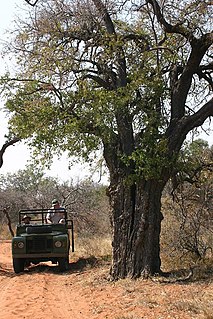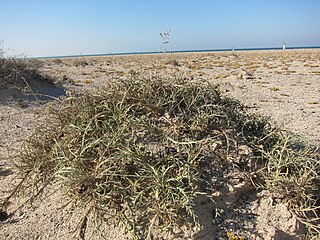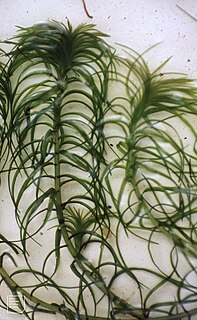
Tulbaghia is a genus of monocotyledonous herbaceous perennial bulbs native to Africa, belonging to the Amaryllis family. It is one of only two known genera in the society garlic tribe within the onion subfamily. The genus was named for Ryk Tulbagh (1699–1771), one time governor of The Cape of Good Hope.

Ricinodendreae is a tribe of the subfamily Crotonoideae, under the family Euphorbiaceae. It comprises 3 genera.
Erythrococca is a plant genus of the family Euphorbiaceae, first described in 1849. It is native to Africa and the Arabian Peninsula.
Cephalocroton is a genus of plant of the family Euphorbiaceae first described as a genus in 1841. It is native to central, eastern, and southern Africa from Nigeria and Ethiopia south to KwaZulu-Natal.
Tragiella is a genus of plant of the family Euphorbiaceae first described as a genus in 1919. It is native to Africa.
- Tragiella anomala(Prain) Pax & K.Hoffm. - Tanzania, Malawi, Zambia
- Tragiella frieseana(Prain) Pax & K.Hoffm. - Zambia
- Tragiella natalensis(Sond.) Pax & K.Hoffm. - South Sudan, Kenya, Tanzania, Uganda, Malawi, Mozambique, Zimbabwe, Cape Province, KwaZulu-Natal, Limpopo, Mpumalanga
- Tragiella pyxostigmaRadcl.-Sm. - Tanzania

Spirostachys is a plant genus of the family Euphorbiaceae first described as a genus in 1850. It is native to Africa. Zuloaga, F. O., O. Morrone, M. J. Belgrano, C. Marticorena & E. Marchesi. (eds.) 2008. Catálogo de las plantas vasculares del Cono Sur. Monographs in systematic botany from the Missouri Botanical Garden 107(1–3): i–xcvi, 1–3348.
Craspedorhachis is a genus of African plants in the grass family.

Sorghastrum is a genus of grasses, native to Africa and the Americas.
Stereochlaena is a genus of African plants in the grass family.

Odyssea is a genus of African and Arabian plants in the grass family.

Axiocerses tjoane, the eastern scarlet, common scarlet or scarlet butterfly, is a butterfly of the family Lycaenidae. It is found in southern and eastern Africa.

Sarangesa seineri, the dusted elfin or dark elfin, is a butterfly of the family Hesperiidae. It is found in Natal, the former Transvaal and Botswana and from Zimbabwe to Kenya and the DRC.

Junonia natalica, the Natal pansy or brown pansy, is a butterfly of the family Nymphalidae. It is found in the Afrotropical realm.

Lagarosiphon is a genus of aquatic plants described as a genus in 1841. It is native to Africa and Madagascar. It is dioecious, with male and female flowers produced on separate plants.
- Lagarosiphon cordofanus(Hochst.) Casp. - Cameroon + Ethiopia to Namibia + Mpumalanga
- Lagarosiphon hydrilloidesRendle - Ghana, Kenya, Uganda
- Lagarosiphon ilicifoliusOberm. - Uganda to Namibia
- Lagarosiphon madagascariensisCasp. - Madagascar
- Lagarosiphon major(Ridl.) Moss - Zimbabwe, Botswana, Lesotho, South Africa
- Lagarosiphon muscoidesHarv. - Mali to Sudan to KwaZulu-Natal
- Lagarosiphon rubellusRidl. - Angola
- Lagarosiphon steudneriCasp. - Ethiopia
- Lagarosiphon verticillifoliusOberm. - Mozambique, Zimibabwe, KwaZulu-Natal, Swaziland, Mpumalanga, Limpopo

Englerophytum is a group of trees in the family Sapotaceae described as a genus in 1914.

Tinnea is a genus of plants in the family Lamiaceae first described in 1867. It is native to sub-Saharan Africa. It was named in honour of the Dutch explorer Alexine Tinne.
- Tinnea aethiopicaKotschy ex Hook.f. - widespread from Mali to Somalia south to Mozambique; naturalized in Trinidad & Tobago
- Tinnea antiscorbuticaWelw. - Zaïre, Zambia, Angola
- Tinnea apiculataRobyns & Lebrun - eastern Africa from Rwanda to Mozambique
- Tinnea barbataVollesen - Swaziland, northern South Africa
- Tinnea barteriGürke - western Africa
- Tinnea benguellensisGürke - Angola
- Tinnea coeruleaGürke - Zaïre, Zambia, Angola
- Tinnea eriocalyxWelw. - Zaïre, Angola, Botswana, Namibia
- Tinnea galpiniiBriq. - Mozambique, Swaziland, South Africa
- Tinnea gossweileriRobyns & Lebrun - Angola
- Tinnea gracilisGürke - Tanzania to Zambia
- Tinnea mirabilis(Bullock) Vollesen - Tanzania
- Tinnea physalisE.A.Bruce - Tanzania
- Tinnea platyphyllaBriq. - Zaïre
- Tinnea rhodesianaS.Moore - South Africa, Namibia, Zimbabwe, Zambia, Angola, Mozambique
- Tinnea somalensisGürke ex Chiov. - Ethiopia
- Tinnea vesiculosaGürke - Tanzania, Malawi
- Tinnea vestitaBaker - Zimbabwe, Zambia, Angola, Botswana
- Tinnea zambesiacaBaker - Zimbabwe, Zambia, Malawi, Mozambique

Aeollanthus is a genus in the mint family, Lamiaceae. All the species are native to Africa.
Trichoneura is a genus of plants in the grass family. It has a scattered distribution in Africa, Arabia, and the Americas.
The Zambezian region is a large biogeographical region in Africa. The Zambezian region includes woodlands, savannas, grasslands, and thickets, extending from east to west in a broad belt across the continent. The Zambezian region lies south of the rainforests of the Guineo-Congolian region. The Zambezian region is bounded by deserts and xeric shrublands on the southwest, the Highveld grasslands of South Africa to the south, and the subtropical Maputaland forests on the southeast.












